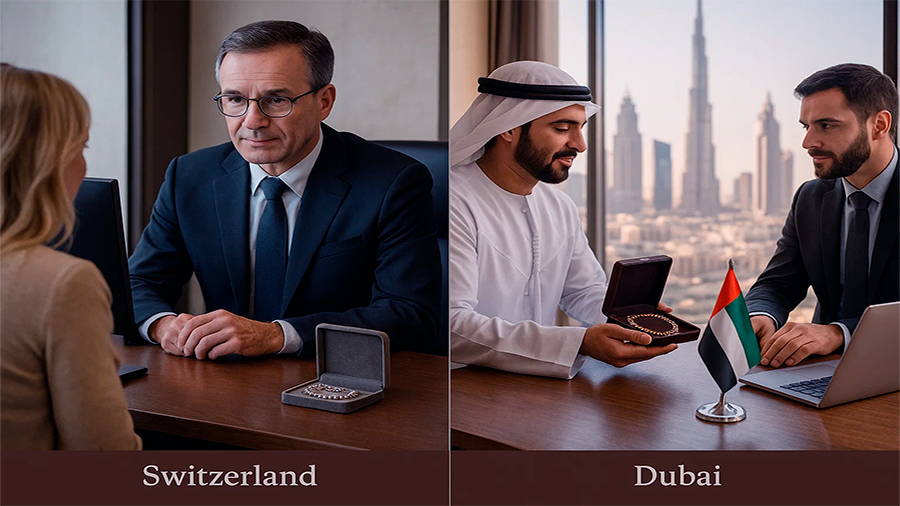Jewellery-Backed Loans in Switzerland and Dubai: Comparing Stability, Liquidity, and Future Trends in Luxury Asset Lending
Loans Secured by Jewellery Assets in Switzerland and Dubai
Jewellery has always carried value, but in financial hubs such as Switzerland and Dubai, it has become more than a luxury possession. Banks and private lenders increasingly treat diamonds, gold, and rare pieces as collateral for loans. For borrowers, this means access to liquidity without selling prized items. For lenders, it opens a niche where tangible, mobile, and globally recognized assets serve as security. The systems in both regions show how financial culture shapes lending: Switzerland focuses on structure and wealth management, while Dubai emphasizes speed and trade. Together, they illustrate how jewellery fits into modern credit markets.
Switzerland: Tradition Meets Structured Lending
Swiss banking has a reputation for discretion and reliability, and jewellery-backed loans align with both traits. In Switzerland, rare stones and fine jewellery are increasingly integrated into structured lending products. Instead of liquidating collections, borrowers pledge them for credit lines. These loans are often linked with wider wealth strategies, alongside equities, bonds, and property. The process is cautious and rigorous: professional gemologists handle valuations, and loan-to-value ratios are kept conservative, usually between 40 and 60 percent. The stability of the system appeals to collectors and high-net-worth individuals who value careful structuring more than fast access to funds.
How It Works in Practice
Consider a client with a collection of diamonds appraised by certified experts. The bank offers a revolving credit line equal to half the appraised value. The borrower then uses the funds for investment in another business, all while maintaining ownership of the jewellery. The key advantage is flexibility: liquidity is released without dismantling existing assets, and the jewellery remains part of the client’s wealth portfolio.
| Feature | Swiss Model |
|---|---|
| Loan-to-Value Ratio | 40–60% |
| Appraisal | Strict, certified gemologists |
| Integration | Wealth management focus |
Dubai: Flexibility and Trade Orientation
Dubai approaches jewellery lending with speed and trade in mind. As one of the world’s leading hubs for gold and diamond trading, the city adapts its lending structures to match the pace of commerce. Borrowers often approach specialized lenders, family offices, or trade-focused institutions rather than traditional banks. The emphasis is on flexibility, with loan-to-value ratios sometimes reaching 70 percent. Valuations are market-driven and often completed within days. For traders and wholesalers, this immediacy is vital—funds are needed quickly to cover shipments or secure deals. Jewellery here functions less as a portfolio asset and more as working capital.
Real-World Scenario
A jewellery wholesaler pledges part of their diamond inventory to a Dubai lender. Within a week, the loan is approved, and cash is released to finance an incoming shipment. After the goods are sold, the loan is repaid, and the collateral is returned. The model allows businesses to bridge gaps between trade cycles without pausing operations or selling assets prematurely.
| Feature | Dubai Model |
|---|---|
| Loan-to-Value Ratio | 50–70% |
| Speed | Approval in days |
| Market Orientation | Trade-focused |
Comparing the Two Models
Although Switzerland and Dubai both use jewellery as collateral, the systems reflect very different philosophies. Switzerland offers integration, regulation, and long-term security, making it attractive for collectors who view jewellery as part of their estates. Dubai focuses on liquidity, fast turnaround, and supporting active trading. Borrowers choose based on context: estate planning and structured wealth align with Swiss practices, while immediate trade finance aligns with Dubai’s model. These contrasts highlight how geography and financial culture define how the same asset is treated in lending markets.
Side-by-Side Comparison
| Aspect | Switzerland | Dubai |
|---|---|---|
| Focus | Wealth management | Trade liquidity |
| Duration | Medium to long-term | Short-term |
| Valuation | Detailed, formal | Fast, market-driven |
| Typical Clients | Collectors, estates | Wholesalers, traders |
Risks for Lenders
While borrowers benefit from jewellery-backed loans, lenders face unique risks that set these products apart from conventional lending. Unlike real estate or listed securities, jewellery values can be volatile and difficult to track in real time. Appraisals depend on expert judgment, leaving room for discrepancies. Theft or fraud adds another layer of exposure, as physical assets require secure storage. Global price fluctuations in diamonds, gold, or coloured stones can reduce the value of pledged collateral almost overnight. For banks and private lenders, these risks mean strict loan-to-value ratios, robust insurance coverage, and continuous monitoring of collateral are essential safeguards.
Valuation Challenges
A ruby appraised at one figure during strong auction demand may lose value if buyer interest wanes. This uncertainty makes conservative lending terms necessary.
Operational Risks
Storage, insurance, and verification all add costs and complexity. Any gap in custody chains could expose lenders to losses if disputes arise.

Technology and ESG Factors
The future of jewellery-secured lending may change significantly as technology and sustainability standards reshape financial markets. Both Switzerland and Dubai are beginning to experiment with blockchain for authentication and artificial intelligence for dynamic valuations. Blockchain could provide instant proof of provenance, reducing disputes and fraud. AI could analyze auction data, market movements, and consumer trends, giving lenders real-time insights into asset values. Beyond technology, environmental and ethical considerations are emerging. Stones sourced responsibly may carry higher loan-to-value ratios, while uncertified assets could be discounted. This shift signals the blending of ESG standards into luxury finance.
Blockchain Integration
In Zurich, a client pledges a sapphire ring. Its certification and origin are stored on blockchain, verified instantly. The bank approves a loan in hours rather than weeks. This efficiency reduces barriers, making jewellery a more liquid form of collateral.
Cross-Border Lending
A Dubai trader secures financing from a European lender by using blockchain-verified diamonds as collateral. Because standards are internationally recognized, the loan crosses jurisdictions seamlessly, highlighting the potential for jewellery to become a globalized form of security.
ESG and Ethical Stones
A borrower presents ethically certified diamonds to a Swiss bank. Because of verified sourcing, the bank offers a 65 percent loan-to-value ratio, higher than the norm. In contrast, another borrower presents stones without certification in Dubai and receives only 50 percent. Over time, this practice could create a two-tier lending market, rewarding ethical assets while limiting unverified ones. For collectors and traders, this case highlights how sustainability can directly affect financing capacity.
Conclusion
Loans secured by jewellery assets reflect the flexibility of modern finance. Switzerland provides stability and integration with wealth management, while Dubai emphasizes liquidity and fast trade support. Both models show how tangible luxury assets can function as effective collateral. Yet lenders must weigh risks of valuation, theft, and volatility, ensuring strong safeguards are in place. Looking ahead, technology and sustainability standards will likely transform the process, making jewellery-backed lending faster, more transparent, and more global. For borrowers, jewellery is no longer just a symbol of wealth—it is collateral that can unlock capital, drive business, and secure new opportunities in financial hubs where tradition and innovation meet.












 Financial Analyst & Luxury Asset Lending Specialist
Financial Analyst & Luxury Asset Lending Specialist